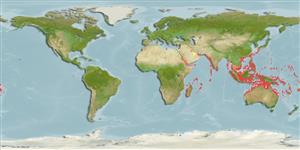Common names from other countries
Environment: milieu / climate zone / depth range / distribution range
Ecologia
marinhas associadas(os) a recifes; intervalo de profundidade 10 - 45 m (Ref. 90102), usually 20 - 42 m (Ref. 9710). Tropical; 23°C - 28°C (Ref. 27115)
Indo-West Pacific: Red Sea south to Natal, South Africa (Ref. 4392) and east to Bali, Indonesia.
Tamanho / Peso / Idade
Maturity: Lm ? range ? - ? cm
Max length : 13.0 cm TL macho/indeterminado; (Ref. 11441)
Espinhos dorsais (total): 9; Raios dorsais moles (total): 12; Espinhos anais 3; Raios anais moles: 12. Body orange-brown, with pale longitudinal blue-green lines following scale rows; head with irregular light blue-green lines; opercular flap with a black spot; caudal fin white with a broad black bar on posterior part of fin (Ref. 4392). Red Sea form is slightly different. Females are distinguished by the white versus yellow band on the base of the tail and males by the lined versus spotted pattern on the body (Ref. 48636).
Adults inhabit lagoon and seaward reefs, usually deeper than 20 m to at least 42 m (Ref. 9710). Juveniles are solitary and adults form small groups, each with several females and a dominant male (Ref. 48636). Oviparous, distinct pairing during breeding (Ref. 205). Minimum depth reported from Ref. 27115.
Life cycle and mating behavior
Maturidade | Reprodução | Desova | Ovos | Fecundidade | Larvas
Oviparous, distinct pairing during breeding (Ref. 205).
Randall, J.E., 1986. Labridae. p. 683-706. In M.M. Smith and P.C. Heemstra (eds.) Smiths' sea fishes. Springer-Verlag, Berlin. (Ref. 4392)
Categoria na Lista Vermelha da IUCN (Ref. 130435)
CITES (Ref. 128078)
Not Evaluated
Ameaça para o homem
Harmless
Utilização humana
Aquário: Espécies comerciais
Mais informação
ReferênciasAquaculturaPerfil para aquaculturaEstirpesGenéticaElectrophoresesHereditariedadeDoençasProcessamentoMass conversion
ColaboradoresFotografiasStamps, Coins Misc.SonsCiguateraVelocidadeTipo de nataçãoÁrea branquialOutras referênciasCérebrosVisão
Ferramentas
Relatórios especiais
Descarregue XML
Fontes da internet
Estimates based on models
Preferred temperature (Ref.
115969): 24.5 - 29, mean 28 (based on 1028 cells).
Phylogenetic diversity index (Ref.
82804): PD
50 = 0.5002 [Uniqueness, from 0.5 = low to 2.0 = high].
Bayesian length-weight: a=0.00977 (0.00470 - 0.02030), b=3.07 (2.89 - 3.25), in cm Total Length, based on LWR estimates for this (Sub)family-body shape (Ref.
93245).
Nível Trófico (Ref.
69278): 3.4 ±0.4 se; based on size and trophs of closest relatives
Resiliência (Ref.
120179): Elevada, tempo mínimo de duplicação da população menor que 15 meses (Preliminary K or Fecundity.).
Fishing Vulnerability (Ref.
59153): Low vulnerability (10 of 100).
